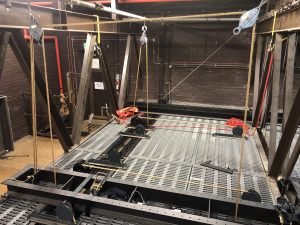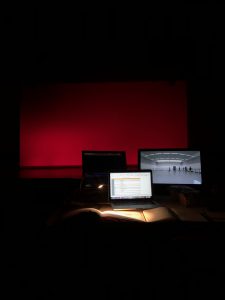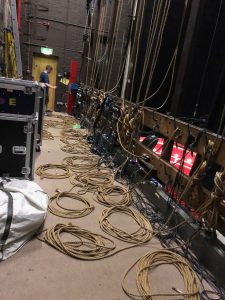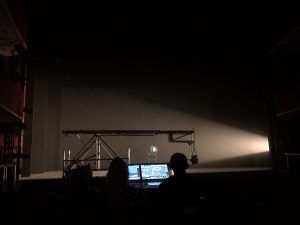Now, where were we? Splitting a journal into two distinct sections like this is certainly different. Writing Part 2 now comes with the notable benefit of hindsight, and the wisdom of looking at the process of the show as a whole, rather than in the midst of the stress and sweat of tech. I’m not saying that any of my previous feelings regarding this allocation were incorrect – on the contrary, reading them now I’m reminded of exactly how raw and accurate my characterisation of those situations were. It’s simply that I now get the opportunity to meditate on what remained of the show with the calm composure that comes with time. That calm composure, as it happened, was something that was definitely not present where Part 1 left off – tech.

Sometimes Rigging Gets Creative
We teched out of order, for reasons I still do not fully understand. Yes, the choreographers were keen to cluster their pieces together to maximise their own time in the venue, but with a show as complex as this, with dancers navigating unrehearsed quick changes, I feel it would have been more kind to them – and the technical team – to tech as the show would actually run. Nevertheless, it was a remarkably smooth process. The fact that we had experienced such productive pre-plotting sessions, and Stephen knew exactly what he wanted each piece to look like helped greatly, and the fact that I had compiled a detailed cloth tracking sheet as we plotted ensured that we could jump from number to number accurately and speedily. The day and a half in which we teched the full show passed in a blur, with only one cloth landing on a performer’s shoulder – through no fault of my own. I would deem that a success.
On the fly floor with me for this show would be Jess – our ATSM – and Greig – borrowed lovingly from the Stage Management department. They served double duty on flys, not only keeping me sane during the 90 minutes from show up to show down, but ensuring that we could fly enough things at the same time that I wasn’t sprinting up and down the fly floor – something the audience would almost certainly hear due to the rather echo-y metal grate it’s built on. I have no reflection on their performance here other than to say that they were both great to work with. They were evidently keen to make the most of this allocation, learn, ask questions, and test my knowledge to the point where I felt like they’d pushed me as a tutor as much as I’d pushed them as crew. Looking forward to the next year, I can only hope every crew member I have on my teams is as proactive as these two – and as astutely keen to tell me to stop talking when I’m boring them with hemp theory.

At Least Plot was Relaxed
And just like that, my last show of Second Year was open. The entire running time of the piece ended up being shorter than Act One of ‘Street Scene’, and a lot more active for the fly crew; nineteen cues and eight live flying pieces keeping us all on our toes. Be it a longing for a Summer break or simply the fact that the sunshine was let in to the venue at every possible occasion, everyone was happy and willing to work with each other, with no petty squabbles or inter-departmental tension to sour the atmosphere. It was an incredibly positive and supportive work environment, and one where we trusted everyone else’s ability to do their job right; something that we all benefited from. Four performances later, and after striking only four movers from the overhead rig, we donned our party wear and headed for the Raddison Blu and the Grad Ball, laving Ballet – and Second Year of RCS – behind.
I have reached no more conclusions after writing this than were noted in my Reflective Summary. Ballet, as an allocation, will always be a good show for any TSM student to finish their second year of study with, especially if it comes on the back of the Opera. In my case, it demonstrated the importance of preparedness, and how knowing your show going into tech makes everyone’s experience dramatically better. It showed that I know how to fly a show and manage a fly crew, and that trusting people to take on cues on your behalf doesn’t make you weak; it shows that you’re efficient. Most of all, it’s shown that – though it may seem challenging at times – biting your tongue and powering through are beneficial skills to have, and that trust in everyone to do their own job will often be rewarded in you being trusted to do yours. I feel confident, now, as a flyman and as a theatre rigger, but it’s the skills I’ve learned regarding managing a team that – I feel – will be most important as I progress into my next allocation. Now… to the Fringe.


